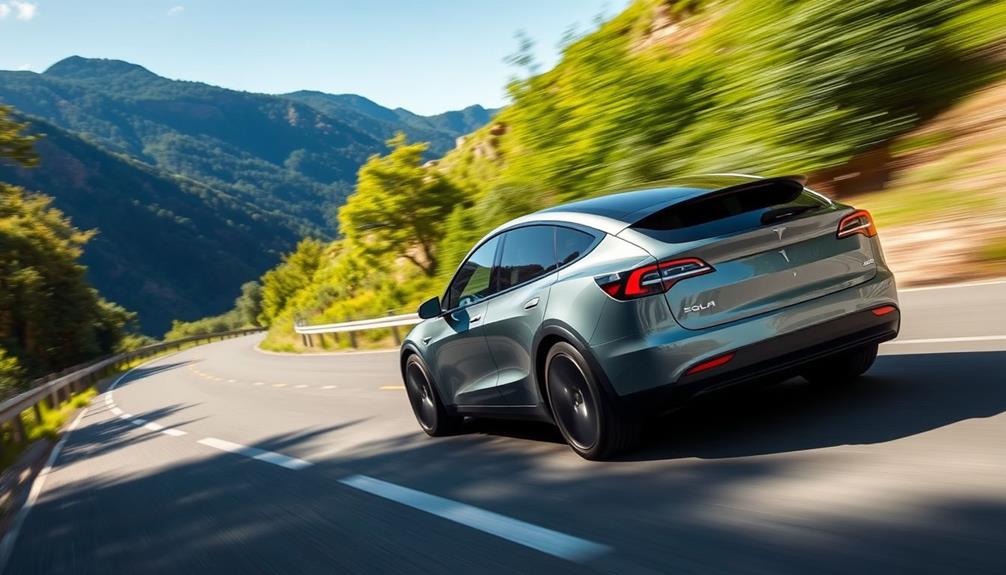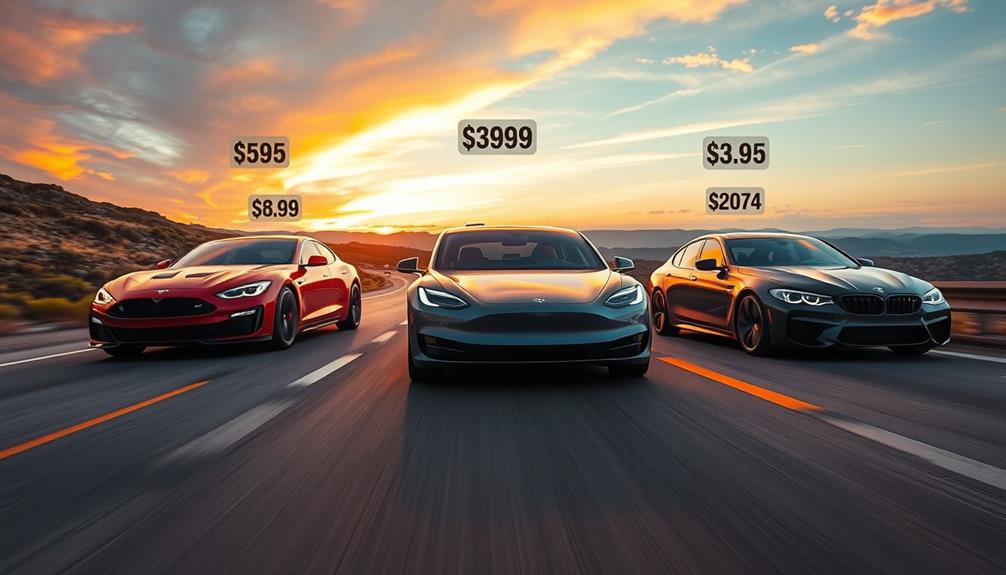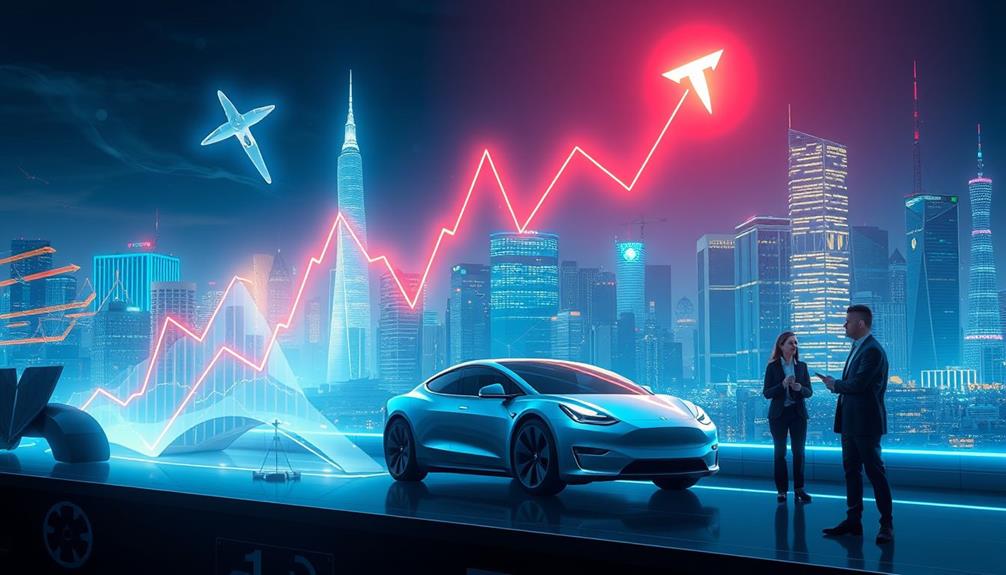Tesla vehicles offer remarkable top speeds, making them among the fastest electric cars on the market. The Model S Plaid can hit an impressive 200 mph, while the Model 3 Performance reaches 162 mph. If you're interested in SUVs, the Model X caps out at 149 mph. The Model Y performs well too, with a top speed of 155 mph. Each model showcases swift acceleration, like the Model S Plaid's zero to sixty in just 1.99 seconds. Want to discover more about Tesla's performance metrics and how they compare to competitors? Keep going!
Key Takeaways
- The Tesla Model 3 Performance has a top speed of 162 mph, making it a fast sedan option.
- The Tesla Model Y reaches a top speed of 155 mph, enhancing its performance as an SUV.
- The Tesla Model S can achieve a top speed of 166 mph, and with modifications, up to 200 mph.
- The Model X has a top speed of 149 mph, maintaining competitive performance among luxury SUVs.
- Tesla vehicles demonstrate impressive capabilities, with several models exceeding 140 mph in top speed.
Tesla Model 3 Top Speed

When it comes to speed, the Tesla Model 3 offers impressive options across its variants. If you're looking for an electric car that combines performance with a sleek design, the Model 3 has got you covered.
The Standard Range variant has a top speed of 130 mph and can accelerate from 0 to 60 mph in just 5.6 seconds. If you upgrade to the Standard Range Plus, you'll enjoy a top speed of 140 mph and a quicker 0-60 time of 5.3 seconds.
But if you crave ultimate performance, the Model 3 Performance edition is the one for you. With a top speed of 162 mph and the ability to rocket from 0 to 60 mph in only 3.1 seconds, this variant truly stands out in the electric vehicle market.
All Model 3 versions boast a 5-star safety rating, proving that you don't have to sacrifice safety for speed.
The electric powertrain allows for rapid acceleration, making the Tesla Model 3 a top choice among electric cars for those who prioritize both performance and safety.
Tesla Model Y Performance

The Tesla Model Y Performance takes the impressive speed of the Model 3 and elevates it within the SUV segment. With a remarkable acceleration from 0 to 60 mph in just 3.5 seconds, it's hard not to be impressed by what this electric SUV offers. Its top speed reaches 155 mph, placing it among the fastest SUVs in its class.
Here's a quick look at some key specifications:
| Feature | Specification | Notes |
|---|---|---|
| Acceleration (0-60 mph) | 3.5 seconds | Instant torque from electric drive |
| Top Speed | 155 mph | Competitive in the performance market |
| Drive System | Dual-Motor AWD | Enhanced traction and handling |
The Model Y Performance's dual-motor all-wheel drive setup provides exceptional traction, ensuring you can handle high-speed maneuvers with ease. Compared to performance vehicles like the 2024 Toyota Supra, the Model Y Performance showcases an edge that's hard to ignore. So, if you're looking for an SUV that combines speed and versatility, the Model Y Performance is definitely worth considering.
Tesla Model S Specifications

When you look at the Tesla Model S, you'll be impressed by its acceleration and power metrics.
With a staggering 1,020 horsepower, it rockets from 0 to 60 mph in just 1.99 seconds, showcasing its incredible performance.
Plus, with the right modifications, you can push its top speed even further, making it a true powerhouse on the road.
Acceleration and Power Metrics
With a remarkable 1,020-horsepower drivetrain, the Tesla Model S Plaid delivers astonishing acceleration and power metrics that redefine electric vehicle performance.
You'll appreciate that this powerhouse can rocket from 0 to 60 mph in just 1.99 seconds under controlled conditions, making it one of the fastest cars on the market. When you push the pedal, the car showcases its incredible acceleration, completing a quarter-mile in approximately 9.2 seconds.
The Model S Plaid achieves a normal top speed of 166 mph, but with a track package and carbon ceramic brakes, you can push it to an impressive 200 mph.
In real-world tests, it's been clocked at a staggering 203.8 mph on the German autobahn, proving that this vehicle's power isn't just theoretical.
Additionally, if you're keen to experience high-speed thrills, you'll find that it can hit 100 mph in about 8.2 seconds, further demonstrating its remarkable power and performance metrics.
The Tesla Model S Plaid not only redefines acceleration but also sets new standards for electric vehicle capabilities.
Speed Limitations and Modifications
Speed enthusiasts often find themselves curious about the Tesla Model S's speed limitations and the potential for modifications. The standard Model S is software-limited to a top speed of about 130 mph, but with the right upgrades, you can release its true potential.
For instance, enhancements like carbon ceramic brakes can help you reach a theoretical top speed of 200 mph, while the standard model can hit 175 mph without these modifications.
It's impressive that the Model S achieves 0-60 mph in as little as 1.99 seconds, showcasing its remarkable acceleration despite its speed limitations. However, driving above 130 mph is considered reckless driving in many areas, and if you plan to venture into higher speeds, you'll need to guarantee your tires, brakes, and suspension are upgraded for safety and performance.
Some users have reported surpassing the 130 mph limit under specific conditions, suggesting that with the right modifications, the Model S can reliably perform at higher speeds.
Tesla Model X Capabilities

The Tesla Model X stands out in the SUV market, boasting remarkable acceleration and performance capabilities. If you're looking for a blend of utility and speed, this vehicle won't disappoint.
The standard Tesla Model X can sprint from 0-60 mph in just 3.8 seconds, which is impressive for an SUV. If you crave more power, the Model X Plaid variant takes it to the next level, achieving 0-60 mph in a jaw-dropping 2.5 seconds, rivaling some high-performance sports cars.
Both versions of the Model X have a top speed of 149 mph, showcasing strong performance capabilities that put it in direct competition with luxury SUVs like the Lamborghini Countach and BMW X6 M.
The vehicle's dual-motor setup guarantees all-wheel drive, enhancing traction and stability, especially at high speeds. This design not only improves acceleration numbers but also gives you confidence when maneuvering various driving conditions.
Acceleration Comparisons

When it comes to acceleration, the Tesla Model S Plaid leaves the competition in the dust with a jaw-dropping 0-60 mph time of just 1.99 seconds.
You'll see how other models like the Model 3 Performance and Model X Plaid stack up against traditional sports cars and SUVs.
Let's explore the real-world acceleration times that highlight Tesla's impressive performance.
Tesla Model S Plaid
Acceleration enthusiasts can't help but marvel at the Tesla Model S Plaid's jaw-dropping performance. This electric powerhouse can rocket from 0 to 60 mph in just 1.99 seconds under controlled conditions, with real-world tests showing impressive times between 2.28 and 2.3 seconds.
Its quarter-mile dash clocks in at around 9.2 seconds, solidifying its reputation as a top contender in the high-performance EV arena.
When it comes to top speed, the Model S Plaid is officially capped at 200 mph, but reports indicate it can soar up to 217 mph with the right upgrades. This electric marvel outpaces competitors, such as the Lucid Air Sapphire, which hits 0-60 mph in 1.98 seconds, highlighting the Plaid's edge in acceleration.
The exhilarating performance of the Tesla Model S Plaid places it among the fastest production cars ever made, leaving many traditional combustion-powered vehicles, like the McLaren 765LT, in the dust.
With its combination of rapid acceleration and impressive top speed, the Model S Plaid is truly a game-changer in the world of electric performance cars.
Performance Vs. Competitors
With a staggering 0-60 mph time of just 1.99 seconds, the Tesla Model S Plaid sets a high bar for performance in the electric vehicle market. This incredible acceleration places it ahead of rivals like the Porsche Taycan Turbo S, which takes 2.4 seconds for the same sprint. The Lucid Air Sapphire is neck-and-neck, claiming a 1.98-second time, showcasing the fierce competition in electric performance.
The Tesla lineup doesn't stop there; the Model X Plaid achieves 0-60 mph in 2.5 seconds, rivaling supercars like the Lamborghini Countach. Meanwhile, the Model 3 Performance and Model Y Performance still impress with their times of 3.1 seconds and 3.5 seconds, respectively. These figures highlight Tesla's dominance in the performance SUV and sedan segments.
Here's a quick comparison of Tesla's acceleration times against some competitors:
| Vehicle | 0-60 mph Time |
|---|---|
| Tesla Model S Plaid | 1.99 seconds |
| Lucid Air Sapphire | 1.98 seconds |
| Porsche Taycan Turbo S | 2.4 seconds |
| Tesla Model X Plaid | 2.5 seconds |
| Tesla Model 3 Performance | 3.1 seconds |
Real-World Acceleration Times
Real-world acceleration times often tell a different story than manufacturer claims, and Tesla's performance figures are no exception. For instance, the Tesla Model S Plaid boasts a stunning 0-60 mph time of 1.99 seconds under controlled conditions. However, in real-world tests, you might see figures ranging between 2.28 and 2.3 seconds. These times still impress, showcasing the model as one of the fastest production cars available.
The Model 3 Performance edition offers a competitive 0-60 mph in just 3.1 seconds, while the Model X Plaid accelerates in about 2.5 seconds, proving that Tesla isn't just about speed for sedans—SUVs can perform too.
When you compare these results to competitors like the Lucid Air Sapphire, which achieves 0-60 mph in 1.98 seconds, it becomes clear that Tesla consistently delivers remarkable acceleration.
Even as you push the speed of 140 mph, Tesla's electric vehicles maintain their impressive capabilities, keeping you firmly planted in your seat.
Pricing and Competitors

Often considered a leader in the electric vehicle market, Tesla's pricing and competition reflect the brand's high-performance aspirations. The base price for the 2024 Tesla Model S Plaid starts at $89,990, with options pushing it to around $113,380.
When you look at competitors, the Lucid Air Sapphire stands out, boasting a blistering 0-60 mph time of just 1.98 seconds and a top speed of 205 mph.
The Porsche Taycan Turbo S is another notable rival, featuring a 0-60 mph acceleration of 2.4 seconds and a top speed of 162 mph, making it a strong contender in the high-performance EV market.
If you're considering an SUV, the Tesla Model X Plaid, priced at approximately $99,990, showcases impressive performance with a 0-60 mph time of 2.74-2.8 seconds.
The Audi RS E-Tron GT also enters the ring, achieving 0-60 mph in 2.9 seconds and a top speed of 155 mph.
With a variety of pricing options and competitors that match Tesla's focus on performance, you have plenty of choices in this fast-evolving electric vehicle landscape.
Frequently Asked Questions
How Fast Can a Tesla Go at Full Speed?
When you're curious about Tesla's speed, you'll find models like the Model S Plaid can reach up to 200 mph, while the Model 3 Performance hits 162 mph, showcasing impressive performance across the lineup.
What Speed Does a Tesla Top Out At?
Imagine racing a lightning bolt; that's how fast a Tesla can go. Depending on the model and upgrades, you can experience top speeds from 135 mph to an exhilarating 200 mph. Buckle up!
How Fast Does a Tesla Pick up Speed?
When you accelerate in a Tesla, you'll feel the rush. The Model S Plaid hits 0-60 mph in just 1.99 seconds, while other models like the Model 3 and Y deliver impressive speed too.
Can You Limit the Top Speed of a Tesla?
Imagine setting your Tesla's top speed to 90 mph for added safety. You can limit the top speed through the car's settings, ensuring a controlled driving experience without compromising performance or safety features.
Conclusion
To sum up, whether you're zipping around in a Model 3 or cruising in a Model S, Tesla's top speeds are sure to impress. You'll feel like you're in a futuristic spaceship every time you hit the accelerator. While pricing and competitors might make you ponder, the thrill of Tesla's performance is hard to beat. So, if you're ready to leave the gas guzzlers in the dust, jump in and experience the electric revolution firsthand! Plus, with Tesla’s ever-growing Supercharger network, range anxiety becomes a thing of the past, allowing you to embark on long road trips with confidence. The cutting-edge tech features, like Autopilot and over-the-air updates, only add to the excitement and convenience of driving one of these cars. So, when you find yourself asking, is owning a Tesla worth it, consider the blend of performance, innovation, and sustainability that comes with every drive.










